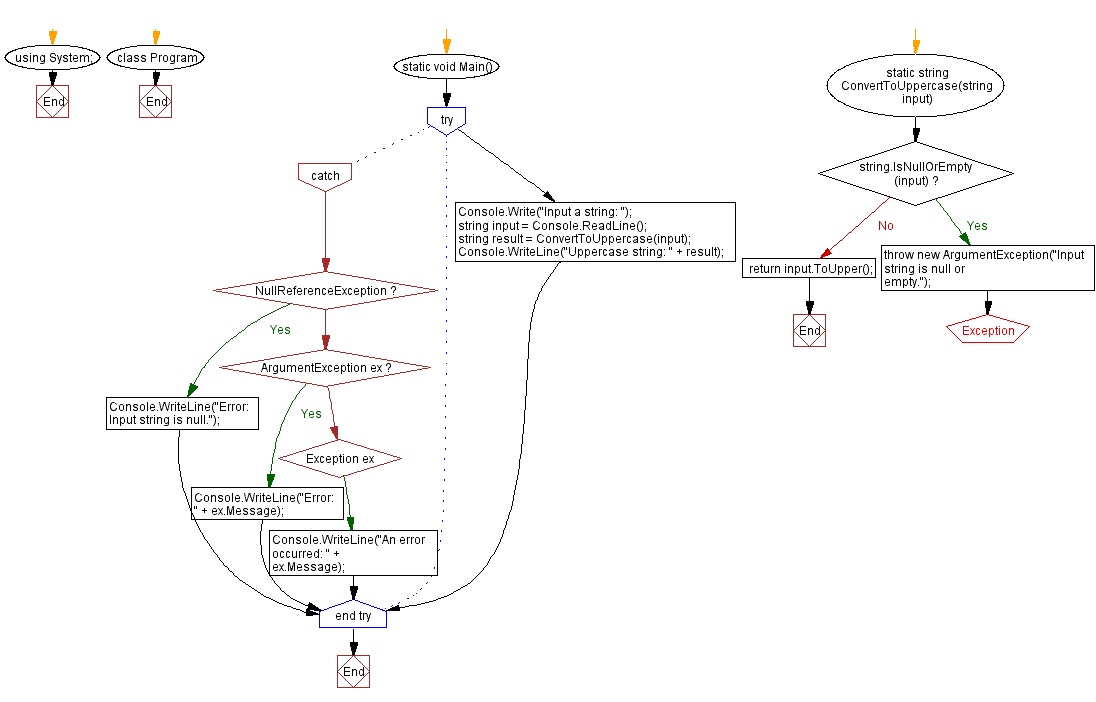C# Program: Convert string to uppercase with exception handling
Write a C# program that creates a method that takes a string as input and converts it to uppercase. Handle the NullReferenceException that occurs if the input string is null.
Sample Solution:
C# Sharp Code:
using System;
class Program {
static void Main() {
try {
// Ask the user to input a string
Console.Write("Input a string: ");
string input = Console.ReadLine();
// Convert the input string to uppercase
string result = ConvertToUppercase(input);
// Display the converted uppercase string
Console.WriteLine("Uppercase string: " + result);
} catch (NullReferenceException) {
// Catch block for handling NullReferenceException (null input)
Console.WriteLine("Error: Input string is null.");
} catch (ArgumentException ex) {
// Catch block for handling ArgumentException (null or empty input)
Console.WriteLine("Error: " + ex.Message);
} catch (Exception ex) {
// Catch block for handling other types of exceptions
Console.WriteLine("An error occurred: " + ex.Message);
}
}
// Method to convert a string to uppercase
static string ConvertToUppercase(string input) {
// Check if the input string is null or empty
if (string.IsNullOrEmpty(input)) {
// Throw an ArgumentException if the input is null or empty
throw new ArgumentException("Input string is null or empty.");
}
// Convert the input string to uppercase using the ToUpper method
return input.ToUpper();
}
}
Sample Output:
Input a string: Error: Input string is null or empty.
Input a string: java Uppercase string: JAVA
Input a string: Java Uppercase string: JAVA
Explanation:
In the above exercise -
- Inside the "Main()" method, a try block is used to enclose code that may throw exceptions.
- The program prompts the user to input a number using Console.Write() to display the message and Console.ReadLine to read the input as a string.
- The input is converted to double using Convert.ToDouble. If the input is a valid number, it is stored in the number variable.
- An if statement checks if the number is greater than or equal to 0. If it is, the program calls the CalculateSquareRoot method to calculate the square root of the number.
- If the number is negative, an ArgumentException is thrown with the message "Number cannot be negative!" using the throw keyword.
- The catch block follows the try block to handle specific exceptions.
- The first catch block catches a FormatException, which occurs if the user enters invalid input that cannot be converted to a double. In this case, it displays an error message: "Error: Invalid input. Please input a valid number."
- The second catch block catches an ArgumentException, which is thrown when the number is negative. It displays the error message contained within the exception.
- The last catch block catches any other exceptions and displays a generic error message along with the exception message.
- The CalculateSquareRoot method takes a double parameter number and uses the Math.Sqrt method to calculate the square root of the number. It returns the result.
Flowchart:

Go to:
PREV : Calculate square root with exception handling.
NEXT : Calculate factorial with overflow exception handling.
C# Sharp Code Editor:
Improve this sample solution and post your code through Disqus
What is the difficulty level of this exercise?
Test your Programming skills with w3resource's quiz.
